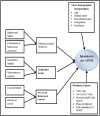Intention to use maternity waiting home and associated factors among pregnant women in Gamo Gofa zone, Southern Ethiopia, 2019
- PMID: 33983992
- PMCID: PMC8118329
- DOI: 10.1371/journal.pone.0251196
Intention to use maternity waiting home and associated factors among pregnant women in Gamo Gofa zone, Southern Ethiopia, 2019
Abstract
Background: A maternity waiting home is a temporary residence in which pregnant women from remote areas wait for their childbirth. It is an approach targeted to advance access to emergency obstetric care services especially, in hard-to-reach areas to escalate institutional delivery to reduce complications that occur during childbirth. Apart from the availability of this service, the intention of pregnant women to utilize the existing service is very important to achieve its goals. Thus, this study aimed to assess the intention to use maternity waiting homes and associated factors among pregnant women.
Methods: Community-based cross-sectional study was conducted among 605 pregnant women using a multistage sampling technique from March 10 to April 10, 2019, by using a structured questionnaire through a face-to-face interview. The collected data was entered into Epi-Data version 3.1 and analyzed using the SPSS version 24 statistical package. Logistic regression analysis was used to test the association. All variables at p-value < 0.25 in bivariate analysis were entered into multivariate analysis. Lastly, a significant association was declared at a P-value of < 0.05 with 95% CI.
Results: In this study, the intention to use maternity waiting homes was 295(48.8%, 95%CI: 47%-55%)). Occupation (government employee) (AOR:2.87,95%CI: 1.54-5.36), previous childbirth history (AOR:2.1,95%CI:1.22-3.57), past experience in maternity waiting home use AOR:4.35,95%CI:2.63-7.18), direct (AOR:1.57,95%CI:1.01-2.47) and indirect (AOR: 2.18, 1.38,3.44) subject norms and direct (AOR:3.00,95%CI:2.03-4.43), and indirect (AOR = 1.84,95%CI:1.25-2.71) perceived behavioral control of respondents were significantly associated variables with intention to use maternity waiting home.
Conclusion: The magnitude of intention to use maternity waiting homes among pregnant women is low. Community disapproval, low self-efficacy, maternal employment, history of previous birth, and past experiences of MWHs utilization are predictors of intention to use MWHs, and intervention programs, such as health education, strengthening and integration of community in health system programs need to be provided.
Conflict of interest statement
The authors have declared that no competing interests exist.
Figures
Similar articles
-
Maternity waiting home utilization and associated factors in the rural community of Dangur District, Northwestern Ethiopia: results from a community-based cross-sectional household survey.BMC Pregnancy Childbirth. 2024 Oct 10;24(1):661. doi: 10.1186/s12884-024-06872-7. BMC Pregnancy Childbirth. 2024. PMID: 39390565 Free PMC article.
-
Intentions to use maternity waiting homes and associated factors in Northwest Ethiopia.BMC Pregnancy Childbirth. 2020 May 11;20(1):281. doi: 10.1186/s12884-020-02982-0. BMC Pregnancy Childbirth. 2020. PMID: 32393188 Free PMC article.
-
Maternity waiting homes as component of birth preparedness and complication readiness for rural women in hard-to-reach areas in Ethiopia.Reprod Health. 2021 Feb 2;18(1):27. doi: 10.1186/s12978-021-01086-y. Reprod Health. 2021. PMID: 33531033 Free PMC article.
-
Institutional delivery service utilization and associated factors in Ethiopia: a systematic review and META-analysis.BMC Pregnancy Childbirth. 2020 Jun 15;20(1):364. doi: 10.1186/s12884-020-03032-5. BMC Pregnancy Childbirth. 2020. PMID: 32539698 Free PMC article.
-
Benefits, barriers and enablers of maternity waiting homes utilization in Ethiopia: an integrative review of national implementation experience to date.BMC Pregnancy Childbirth. 2022 Sep 2;22(1):675. doi: 10.1186/s12884-022-04954-y. BMC Pregnancy Childbirth. 2022. PMID: 36056301 Free PMC article. Review.
Cited by
-
Utilization of maternal waiting home and associated factors among women who gave birth in the last one year, Dabat district, Northwest Ethiopia.PLoS One. 2022 Jul 8;17(7):e0271113. doi: 10.1371/journal.pone.0271113. eCollection 2022. PLoS One. 2022. PMID: 35802568 Free PMC article.
-
Intention to Use and Predictors of Use of Maternity Waiting Home among Pregnant Women in Hargeisa City Health Centers, Somaliland.Patient Prefer Adherence. 2022 Jun 30;16:1595-1603. doi: 10.2147/PPA.S358952. eCollection 2022. Patient Prefer Adherence. 2022. PMID: 35795009 Free PMC article.
-
Maternity Waiting Home Interventions as a Strategy for Improving Birth Outcomes: A Scoping Review and Meta-Analysis.Ann Glob Health. 2022 Jan 18;88(1):8. doi: 10.5334/aogh.3496. eCollection 2022. Ann Glob Health. 2022. PMID: 35087708 Free PMC article.
-
Knowledge and attitude of women towards maternity waiting homes and associated factors among women who gave birth in the last twelve months in Dega Damot district, northwest Ethiopia.Front Glob Womens Health. 2023 Feb 20;4:988328. doi: 10.3389/fgwh.2023.988328. eCollection 2023. Front Glob Womens Health. 2023. PMID: 36891169 Free PMC article.
-
Utilization and determinants of maternity waiting homes among pastoralist mothers in Dire district, southern Ethiopia: a mixed-methods study.Front Glob Womens Health. 2024 Oct 25;5:1446500. doi: 10.3389/fgwh.2024.1446500. eCollection 2024. Front Glob Womens Health. 2024. PMID: 39524498 Free PMC article.
References
-
- World Health Organization. Maternity waiting homes: a review of experiences. World Health Organization; 1996.
-
- Buser JM, Lori JR, Munro-Kramer M, Pitcher K. Cost Analysis of Maternal Waiting Homes in Rural Liberia, 2016.
-
- UNICEF. Innovative approaches to maternal and newborn health. Compendium of Case Studies. Accessed online at http://www.everywomaneverychild.org/images/Innovative_Approaches_MNH_Cas.... 2013.
-
- Fogliati P, Straneo M, Mangi S, Azzimonti G, Kisika F, Putoto G. A new use for an old tool: the maternity waiting homes to improve equity in rural childbirth care. Results from a cross-sectional hospital and community survey in Tanzania. Health policy and planning. 2017. December 1;32(10):1354–60. 10.1093/heapol/czx100 - DOI - PMC - PubMed
-
- Odusola A. Accelerating progress on maternal health in Africa: lessons from emerging policy and institutional innovations. Working Paper No, New York: UNDP; 2013 Dec.
MeSH terms
LinkOut - more resources
Full Text Sources
Other Literature Sources
Miscellaneous



